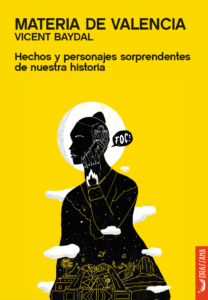 Matèria de València
Matèria de València
Fets i personatges sorprenents de la nostra història
Vicent Baydal
Llibres de la Drassana
Valencia, 2022
210 p.; 24 x 17 cm.
ISBN: 978-84-124383-7-6
¿Sabías que Adolf Hitler tuvo esclavos valencianos durante la Segunda Guerra Mundial? ¿O que una mujer de Alzira, Ginesa, fue amante del rey Jaime I y engendraron un hijo ilegítimo? ¿O que las Fallas de Valencia se celebraron en la ciudad de Tarragona en los años 30? ¿Y por qué nos representa un murciélago, a los valencianos? ¿Quién era el invencible pelotari, y perdulario, Xiquet de Simat, que tuvo una vida de película? ¿O qué castigo aplicó el régimen franquista a las mujeres represaliadas en la posguerra. Todos estos hechos y personajes, que a su manera han forjado el país de los valencianos y las valencianas, los encontraréis en Materia de Valencia, de la sugerente voz del conocido investigador y divulgador Vicent Baydal, junto con muchísimas otras historias sorprendentes. Por ejemplo, la del castellano de Toledo que escribió el Curial e Güelfa, una de las cumbres de la literatura medieval valenciana; la del biznieto del papa Borja, gobernador en Orán, que fue el primer perseguido por homosexualidad por la Inquisición; la de dos alicantinos que fueron fundamentales en la independencia de los Estados Unidos de América; la de Blasco Ibáñez como revolucionario populista desencantado o la de las mujeres fuertes de nuestras letras, como María Beneyto y Carmelina Sánchez-Cutillas. Un delicioso viaje por la materia histórica de la que estamos hechos.
You ca buy here in Spanish or here in Catalan-Valencian.
.
 Barcelona, una capital mediterrània a través de les seves cartes:
Barcelona, una capital mediterrània a través de les seves cartes:
1381-1566
Vicent Baydal
Museu de Barcelona
Barcelona, 2021
180 p.; 21 x 15 cm.
ISSN: 2014-3516
From the late Middle Ages, the sending of letters or epistles became an art and, at the same time, a first-rate communicative, administrative and diplomatic tool. For example, tens of thousands of letters are preserved in the Historical Archive of the City of Barcelona, sent by the municipal governors. This work analyzes those written by the city councilors between the end of the fourteenth century and the middle of the sixteenth century in order to observe the network of epistolary relations of Barcelona. When were letters sent? Why? To whom? Where? How? This epistolary observation shows a city that was not only the undisputed capital of Catalonia, but also one of the main economic and political centres of the western Mediterranean.
.
 La València contada
La València contada
La Ciutat, la mar i els quatre quarters
Vicent Baydal, Frederic Aparisi, Ferran Esquilache
Drassana
Odissea collection
Valencia, 2020
185 p.; 24 x 17 cm.
ISBN: 978-84-120430-8-2
Valencia is one of the fifty most populous metropolises in Europe and one of the oldest cities on the Earth, with more than two thousand years of existence. Its passage through history has been intense and has left deep traces that we often do not know. Here we will take a delicious walk through the origins and monuments of the main historical spots that make it up: El Carme and Velluters neighbourhoods in Ciutat Vella; El Cabanyal in the maritime district; and the so-called four quarters, Patraix, Russafa, Benimaclet and Campanar. Vicent Baydal, Frederic Aparisi and Ferran Esquilache narrate with agility and mastery the past of a city that Tono Giménez has photographed from all points of view.
You can buy the book here. They are Spanish version here
.
 De Carraixet a Bonrepós i Mirambell
De Carraixet a Bonrepós i Mirambell
Els orígens medievals d’un poble valencià
Vicent Baydal, Ferran Esquilache
Institució Alfons el Magnànim – Centre Valencià d’Estudis i Investigacions
Estudis Universitaris collection
Valencia, 2020
208 p.; 20 x 13 cm.
ISBN: 978-84-7822-837-9
The process of birth of the village of Bonrepòs i Mirambell, in the area of l’Horta Nord, Valencia, was completely unknown until now, since no news was known beyond the 15th century. However, now we know the reason: before that date the town was called Carraixet, a name which was later abandoned. By prospecting the landscape of the area and analysing the archival sources, this book shows the origins and evolution of that settlement throughout the Middle Ages. Carraixet must have appeared in the al-Andalus period, at the time of the construction of the Séquia de Montcada by Berber and Arab peasants, and later passed into the hands of Christian settlers, in the epoch of James I. Later, between the fourteenth and fifteenth centuries, several feudal lords are documented, such as the Civera family, who around 1430 changed the name of the village to Bonrepòs, in order to avoid its link to the nearby gallows of Les Forques de Carraixet, settled a few decades earlier. Finally, around 1450, new lords, the Menaguerras, established a “moreria” called Mirambell within the local term, the urban morphology of which has remained until today, becoming a heritage gem. The work, in short, invites us to walk around that time and it is a great example of combining morphological and documentary studies in local history.
You can buy the book here.
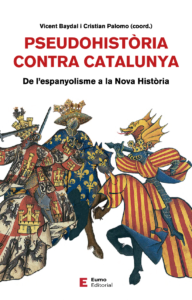 Pseudohistòria contra Catalunya
Pseudohistòria contra Catalunya
De l’espanyolisme a l’Institut Nova Història
Vicent Baydal, Cristian Palomo (coords.)
Eumo
Referents collection
Vic, 2020
460 p.; 21,5 x 13,5 cm.
ISBN: 978-84-9766-689-3
Is it true that Catalonia did not exist until the Treaty of Corbeil in 1258? Or was it a county annexed and subsumed within the Kingdom of Aragon? Did not the Catalans fight in the War of Succession to defend their self-government? These statements are widespread in the media and on social networks and are based on the most extreme historical canon of Spanish nationalism. On the other hand, the Institut Nova Història (INH) states that Miguel de Cervantes, Christopher Columbus, Marco Polo and the Cid were Catalan or Valencian and that the Golden Age of Castilian literature was written in Catalan, but a systematic censorship built by Castile would have been responsible for erasing the Catalan footprint of history. Vicent Baydal, Xevi Camprubí, Stefano M. Cingolani, Guillem Fornés, Cristian Palomo, Cèsar Sànchez, Lluís Ferran Toledano and Alberto Velasco forcefully and thoroughly refute all these pseudo-historical interpretations, based on conscious distortions and falsities, created and disseminated both from of Spanish nationalism and the Institut Nova Història. Only from the historiographical rigor can ignorance and contempt be fought against Catalonia and against Catalan people.
You can buy the book here.
 Els llibres de Consells de la vila de Castelló
Els llibres de Consells de la vila de Castelló
(1411-1417). Volum. 5
Vicent Baydal, Lledó Ruiz
Publicacions de la Universitat de València
Fonts Històriques Valencianes collection
Valencia, 2019
580 p.; 27 x 19 cm.
ISBN: 978-84-9134-536-7
This volume is the fifth contribution to the project of publishing municipal acts or books of the Council of the town of Castellón in the late medieval period and includes the preserved manuscripts of the years 1411-1412, 1414-1415, 1415-1416 and 1416 -1417. As in the previous cases, the books of each annuity appear divided into two parts. The first compiles the municipal acts of the meetings of the justice, the juries and the councillors of the town, with a very diverse content on the agreements taken, the economic management of the municipality, the decisions that affected the daily life and detailed information on political events, such as the war of the Interregnum, the Compromise of Caspe, the visit of Pope Benedict XIII or the death of King Ferdinand of Antequera. The second contains the official accounting of the municipal council during the year of its management, as proof and guarantee of the public expenditure made by the local officials.
You can buy the book here.
 Aigua per al pa, aigua per al sucre
Aigua per al pa, aigua per al sucre
La construcció de les séquies de Palma i d’en March a l’Alfàs de l’Horta de Gandia. Segles XIII i XV
Ferran Esquilache & Frederic Aparisi
Edicions de la Universitat de Lleida
Espai / Temps collection
Lleida, 2019
143 p; 24 x 17
ISBN: 978-84-9144-192-2
This work studies the agricultural landscape of the Séquia de Palma and the Séquia d’en March, two hydraulic systems that are located in the Alfàs area, nestled between the Serpis and Vernisa rivers, in the municipal terms of Ador, Palma and Beniarjó (Valencian Country). Thanks to the combination of the hydraulic archaeology and the written documentation, the study shows that the Séquia de Palma was built in the middle of the 13th century by the Chistian society –although probably partly reusing a canalisation of Andalusi origin– in order to expand the irrigated surface and to consolidate the Christian settlement in Palma and Ador. The Séquia d’en March was built in 1457 thanks to the initiative of Ausias March, lord of the manor of Beniarjó, to increase the sugar production. The new irrigated lands were not exclusively dedicated to the cultivation of the sugar cane, but allowed to increase the production while also guaranteeing the local supply of wheat. Despite the chronological difference and the unequal extend between them, both systems ultimately respond to the same purpose: the increase of the feudal rents.
You can buy the book here.
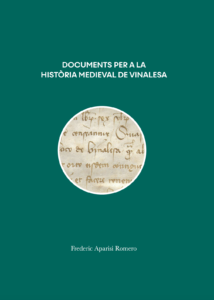 Documents per a la història medieval de Vinalesa
Documents per a la història medieval de Vinalesa
Frederic Aparisi
Elèctrica de Vinalesa
Valencia, 2019
134 p; 26 x 19
ISBN: 978-84-09-16013-6
The name of Vinalesa refers, undoubtedly, to Islamic origins. The Christian conquest meant a break with these origins, not only because the Muslim population was forced out, but also because the village was not occupied immediately after the conquest. The book collects a selection of documents from the fourteenth, fifteenth and sixteenth centuries from various archives that illustrate the demographic and socioeconomic evolution of this rural community at the gates of Valencia.
–
–
–
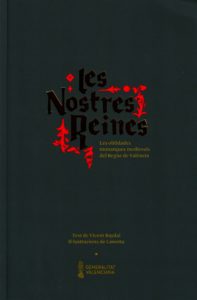 Les nostres reines
Les nostres reines
Les oblidades monarques medievals del Regne de València
Vicent Baydal
Generalitat Valenciana
València, 2019
45 p.; 25 x 16 cm.
Like any other member of the monarchies of the time, the queens of the Crown of Aragon and the Kingdom of Valencia were considered cruel, arbitrary or authoritarian when it came to acting in defense of their social and political privileges. But it is inconceivable that, in spite of all their shadows and their many lights, we barely know them today on an equal footing with their male companions, the kings. That is why, with the illustrations and biographical syntheses we offer in this book, we want to focus on those key women of our past, make them visible and give an introductory taste to their history and their lives, from Violant of Hungary to Germaine of Foix. In short, they are our medieval queens, the most distant, of which we know the least, but the ones that are most directly linked to our moment of birth as a Valencian people, as we celebrate every year on October 9th. For an egalitarian commemoration, also in the vision of gender.
–
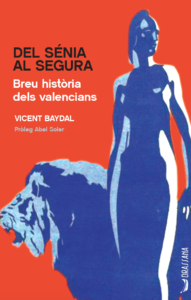 Del Senia al Segura
Del Senia al Segura
Breu història dels valencians
Vicent Baydal
Drassana
Odissea collection
Valencia, 2018
216 p.; 23,5 x 16,5 cm.
ISBN: 978-84-948627-7-9
This is an authored history. We accompany the researcher and divulgator Vicent Baydal aboard a brigand of memories that makes us travel through time to discover two main things: who has passed through the beginning of humanity through this small piece of world that we describe as Valencian and how the human group, the people, that we consider equally Valencian, has been formed and developed. Consisting of a kaleidoscope of unique narratives, this short history of the Valencians could be an adventure novel or a fast-paced operatic performance. It is, in fact, an explosion of concatenated flashbacks, an incredible cabinet of ancestral curiosities, heroes and actions of the past that make us share in the sufferings, glories and hopes of those who preceded us. Here parades the great history of the hunters-gatherers of the Valltorta and the prayers of the plain of Petracos, the Lady of Elx and the Treasure of Villena, the warriors of Llíria and the elephants of Hannibal by Sagunt, the Roman foundation of Valencia and the Byzantines against the Visigoths on the banks of the Xúquer, the Berber peasants who installed irrigation ditches everywhere and James I conquering right and left, the ineffable St. Vincent Ferrer preaching the apocalypse and Joan Baptista Basset leading the maulet armies, the silence that invaded the kingdom after the Battle of Almansa and Vicent Blasco Ibáñez crying out for the republic out loud. But we also delve into the past of the forgotten, such as the “moriscos”, freethinkers or dissidents, and especially the forgotten, such as the printer Jerònima Galés, the austriacist Maria Lluïsa Lamarca, the president of the Canton of Torrevieja Concha Boracino or the artist and writer Josefina Pla, incomprehensibly neglected. An exciting historical journey aimed at those who are interested in acquiring the basic coordinates of the Valencia territory, the Valencia people and the heritage that gives the Valencians a particular value and helps them to walk one step further towards a more free, supportive, critical, conscious and happy collective future.
You can buy the book here. They are Spanish version, and you can buy the book here.
 Els constructors de l’Horta de València
Els constructors de l’Horta de València
Origen, evolució i estructura social d’una gran horta andalusina entre els segles VIII i XII
Ferran Esquilache
Publicacions de la Universitat de València (PUV)
Història collection
Valencia, 2018
496 p; 24 x 16
ISBN: 978-84-9134-372-1
L’Horta of Valencia is the largest and most well-known historical irrigated area in the western Mediterranean and it has been debated for a long time what its origins really were; we now know that they are undoubtedly linked to the al-Andalus period. Beyond this debate, the present work uses the methods of hydraulic archeology and the morphological analysis of agricultural structures to analyze the formation and evolution of the Horta in relation to al-Andalus society, which is the real object of study. At what point, how and why did the peasant groups of al-Andalus built and expand the irrigated system of the Horta of Valencia? Here are proposed various phases of construction, which seem to be related to the evolution and social changes that occurred during that time, and even a hypothesis of chronological adscription for each phase is proposed. The work also analyzes the role played by the city of Valencia as the seat of the market and power, as well as the possible intervention of the Islamic states of al-Andalus in that evolution, in the context of a tributary society.
You can buy the book here.
 València no s’acaba mai // Valencia no se acaba nunca
València no s’acaba mai // Valencia no se acaba nunca
Vicent Baydal
Drassana
Odissea collection
Valencia, 2016
184 p; 23 x 15
ISBN: 978-84-16260-15-7
The stories behind a city like Valencia, with more than two thousand years of existence, are countless. But few know them as much and tell them as well as the researcher and divulgator Vicent Baydal. His passion for History, in capital letters, and for stories, in small letters, goes beyond the pages of this book, which through twenty-three different episodes allows us to discover the most unthinkable aspects of a city that never ends. Its rebirth in the Andalusian era thanks to the construction of the Horta irrigation system, the memorable beauty of the narrow medieval passage that led to the Llonja dels Mercaders, the destructive attacks on the Jewish quarter and the “Moreria” in 1391 and 1455, the violent struggles between factions that dominated the city in the seventeenth century, the geographical expansion of the Falles to unexpected places, and the progressive urban expansion of Valencia, with runaway growth in permanent conflict with an invaluable heritage. The most fascinating characters, key in the history of the city, also run through these pages: the Byzantine empress Constance of Hohenstaufen, the jurist and popular hero Francesc de Vinatea, the humanist typographer Jerònima Galés, the bookseller, publisher and bibliophile Vicent Salvà, the prodigious Indiano Josep Rodrigo Botet and the fundamental architect of modernity Javier Goerlich. In short, an exciting and fascinating trip that will surprise all those eager for Valencian stories.
You can buy it here (Catalan-Valencian) or here (Spanish).
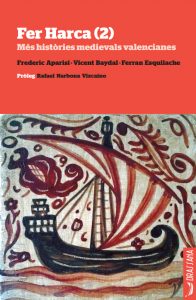 Fer Harca (2)
Fer Harca (2)
Més Històries Medievals valencianes
Frederic Aparisi, Vicent Baydal and Ferran Esquilache
Drassana
Odissea collection
Valencia, 2016
126 p; 23 x 15
ISBN: 978-84-944731-4-2
This book is a collection of writings by Harca Group, which is well-known in the social networks and the internet due to the intense activity in spreading the medieval Valencian history. The prologue is written by Enric Guinot, professor of Medieval History of the University of Valencia. And the texts are written and revised by Frederic Aparisi, Vicent Baydal and Ferran Esquilache members nowadays of Harca Group. With a lively and dynamic speech, the three authors bring us a bunch of surprising histories. Why is rice so present in the Valencian cuisine? Why is Russafa neighbourhood named and what relationship it has with Al-Andalus? For which reasons did Vinatea rebel against the Castilian authoritarianism? Why was so famous the medieval brothel of the city of Valencia? What did almogavers bring from medieval Greece to Valencia? What did after the Moriscos expulsion happen? Since when Valencian people did they begin to feel like ones? Up to sixteen different histories constitute a fascinating and captivating trip to the medieval Valencia and far away.
You can buy the book here.
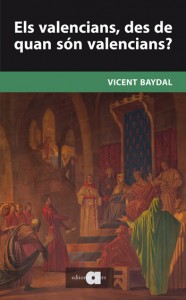 Els valencians, des de quan són valencians?
Els valencians, des de quan són valencians?
Vicent Baydal
Editorial Afers
Recerca i pensament collection
Catarroja (Valencia), 2016
166 p; 21 x 14 cm.
ISBN: 978-84-16260-15-7
Until very recently the empirical study of the origins of the identity linked to the political community of the medieval Kingdom of Valencia has remained virtually unexplored. In this book Vicent Baydal examines it with all kind of details from the creation of the kingdom in 1238, after the conquest of James I, until the decade of 1360, in which the Valencian Parliament and the Deputy of the General were consolidated as governmental institutions. The result is a former date for the birth of the Valencian identity, almost half a century earlier than thought, parallel to the progress of the jurisdictional and legal unification of the kingdom during his first hundred and twenty-five years of history. In particular, the defense of the Laws of Valencia, first against the Aragonese nobility and later the very kings, and the development of political cooperation required by the wars of the mid-fourteenth century against the Marinids, Genoese and Castilians, gave as a result the emergence of a collective consciousness that differentiated the inhabitants of the Kingdom of Valencia, the Valencians, from other peoples of the Crown of Aragon and the rest of Europe.
You can buy the book here. They are Spanish version too, published by Drassana, and you can buy it here.
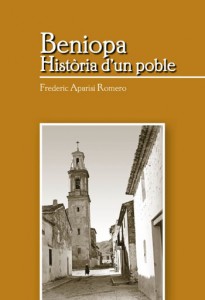 Beniopa. Història d’un poble
Beniopa. Història d’un poble
Frederic Aparisi
Council of Gandia
Gandia (Valencia), 2015
191 p; 24 x 17 cm
ISBN: 9788493622251
In 1965, the villages of Beniopa and Benipeixcar were incorporated into the city if Gandia what meant losing their economic and administrative independence. Because of the fiftieth anniversary of the loss of the juridical autonomy of the Council, in 2015 was carried out a research project about the history of Beniopa. This is not a local history in the worst meaning of the adjective. By the contrary, from the local observatory, the author analyses historical phenomena and processes of wider scope. It is not a work of summary of previous researches, which did not exist, neither a spreading work, although the author uses an accessible language for a vast audience. This publication is, therefore, a research book from the perspective of the long run. So, among other issues, the Islamic conquest, the expansion of feudal society, the relations between the city and countryside or the differentiation in the peasant society are some of the topics analysed in this book. The birth of democratic societies and the difficulties of consolidating them through the 19th the 20th centuries occupy the fourth and fifth chapters. To conclude, the author revises both the main buildings and areas that constitute the landscape of Beniopa.
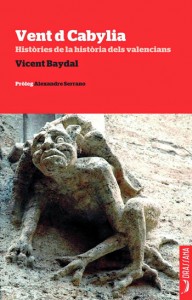 Vent d Cabylia
Històries de la Història dels valencians
Vent d Cabylia
Històries de la Història dels valencians
Vicent Baydal
Drassana
Odissea collection
Valencia, 2015
116 p; 23 x 15 cm.
ISBN: 9788494388545
Vent d Cabylia is a pun, an anagram formed by the letters of the name of the known Valencian researcher and commentator Vicent Baydal. In this book he also proposes a game: to know and enjoy the history of the Valencian people beyond the deeds that we have been traditionally told. Through his tireless research he shows us all kinds of stories about the history of the Valencians, their language, their symbols, their identity, their culture, their relations with other peoples, their historical claims, their outstanding characters and their future as a community. Those peculiar accounts give substance to this book from the depopulation of the city of Alicante in 1364 during the war against Castile to the history of the emblem of the Valencia FC, the belonging of the island of Formentera to a Valencian knight, the bitter controversies about the expansion of rice cultivation, the circulation of erotic poems in Valencian language, the evolution of this language through the centuries and the historical fame of Valencian people as brave and indomitable. A whole constellation of knowledge and information that makes us to travel delightfully through the history of the Valencians and allows us to think a better future for all.
You can buy the book here.
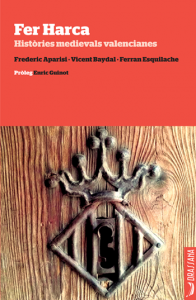 Fer Harca
Fer Harca
Històries Medievals valencianes
Frederic Aparisi, Vicent Baydal, Ferran Esquilache
Drassana
Odissea collection
Valencia, 2014
109 p; 23 x 15
ISBN: 9788494286001
This book is a collection of writings by Harca Group, which is well-known in the social networks and the internet due to the intense activity in spreading the medieval Valencian history. The prologue is written by Enric Guinot, professor of Medieval History of the University of Valencia. And the texts are written and revised by Frederic Aparisi, Vicent Baydal and Ferran Esquilache members nowadays of Harca Group. With a lively and dynamic speech, the three authors bring us a bunch of surprising histories. Why is rice so present in the Valencian cuisine? Why is Russafa neighbourhood named and what relationship it has with Al-Andalus? For which reasons did Vinatea rebel against the Castilian authoritarianism? Why was so famous the medieval brothel of the city of Valencia? What did almogavers bring from medieval Greece to Valencia? What did after the Moriscos expulsion happen? Since when Valencian people did they begin to feel like ones? Up to sixteen different histories constitute a fascinating and captivating trip to the medieval Valencia and far away.
You can buy it here.
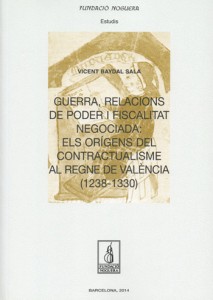 Guerra, relacions de poder i fiscalitat negociada
Guerra, relacions de poder i fiscalitat negociada
Els orígens del contractualisme al regne de València (1238-1330)
Vicent Baydal Sala
Fundació Noguera
Estudis collection
Barcelona, 2014
663 p; 24 x 17
ISBN: 9788499754536
The work studies the process by which power relationships between the monarchy and the estates of the kingdom of Valencia articulated during its first decades, between the 13th and 14th centuries. Two key factors marked those relationships: on the one hand, the struggle of the Aragonese noblemen against the monarchy and the royal burghs for the observance of the Charters of Valencia or the Charters of Aragon inside the Valencian borders, and, on the other hand, the increasing need for the monarchy to expand the fiscal contribution because of its progressive indebtedness caused by wars. Thus, the evolution of the Royal Treasury is studied during the selected period, as well as each and every one of the military campaigns led by the kings and the fiscal negotiations and parliamentary assemblies linked to them. The investigation ends in 1330, when the dispute about the Charters arrived to a consensual solution and the first general subsidy, paid by all the Valencian estates, was given to the King. That laid the foundations for a system of government in which contractualist thesis, as those from Francesc Eiximenis, had a major role.
You can buy the book here.
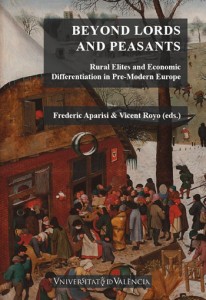 Beyond lords and peasants
Beyond lords and peasants
Rural elites and economic differentiation in Pre-Modern Europe
Frederic Aparisi, Vicent Royo (eds.)
University of Valencia
Valencia, 2014
260 p; 24 x 16
ISBN: 9788437092614
The present volume explores the process of economic stratification within the rural societies in the Middle Ages and in the Pre-modern period, paying special attention to the leading sectors of the community. Established experts and younger scholars in the field examine the rural elites and its relation with the emergence of agrarian capitalism through different observatories ranging across European regions, from Wiltshire (England), the County of Flanders and the Duchy of Brabant (Low Countries) to the Kingdom of Valencia (Crown of Aragon). The contributions analyse the differentiation within the peasantry from various perspectives such as the social conditions, the evolution of communal structures, the investment strategies, the expenses for burials, the means for social promotion and the uses of the common lands. The book employs a variety of historical methods and draws on a wide range of diverse sources including court records, wills, law codes, manuals of institutional landowners and notarial registries. Considering the interest of the issue and the newness of the observatories, this volume will be essential reading for specialists on rural history and also engage a more general readership interested in conditions and structures in pre-industrial societies.
You can buy the book here.
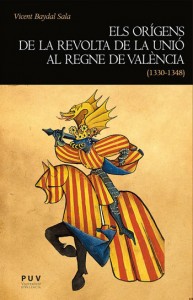 El orígens de la revolta de la Unió al regne de València
El orígens de la revolta de la Unió al regne de València
(1330-1348)
Vicent Baydal Sala
Valencia Unversity Press (PUV)
Història collection
Valencia, 2013
419 p; 24 x 16
ISBN: 9788437091365
This work, Ferran Soldevila Award 2011, analyzes the relationship between the Crown and the Valencian estates from the end of the Parliament of 1329-1330 to the revolt of the Union of 1347-1348. Focusing on political and fiscal aspects, it examines the parliamentary meetings that took place during that period, and the several subsidies that were paid to the royal treasury. All this, the steady erosion of the Crown properties and the huge tax demands caused by the Mediterranean wars, combined with the king’s authoritarianism, led to the outbreak of a rebellion headed by the city of Valencia and seconded by many popular sectors of the kingdom. It includes an extensive appendix with the main political and fiscal agreements reached by the estates and the monarchy.
You can buy the book here.
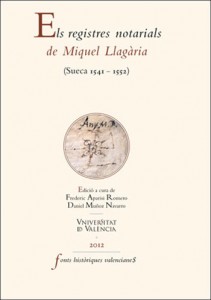 Els registres notarials de Miquel Llagària
Els registres notarials de Miquel Llagària
(Sueca, 1541-1552)
Frederic Aparisi Romero, Daniel Muñoz Navaro
Valencia University Press (PUV)
Fonts Històriques Valencianes collection
Valencia, 2013
600 p; 19 x 27
ISBN: 9788437088822
This volume contains the documentation generated by the notary Miquel Llagària, an activity that lasted for twenty years, from the 1540s until 1561. Coming from Xàtiva, he settled in Sueca, a rural community of the Order of Montesa that was living a time of agricultural expansion. You can follow the daily life of a population made up mostly of farmers through these records. All social and economic life of rural families is reflected in the notarial records from the chapters of marriage to wills, post mortem inventories, purchases, sales, debt or procuratorships. Even the actions of the municipal Council and the lord of Sueca have left a paper trail that includes the collection of taxes as “peita” or “sequiatge” and the leasing of feudal monopolies as the mill or the butcher’s.
You can buy the book here.
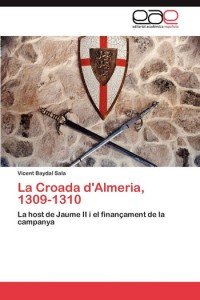 La Croada d’Almeria, 1309-1310
La Croada d’Almeria, 1309-1310
La host de Jaume II i el finançament de la campanya
Vicent Baydal Sala
Editorial Académica Española
Saarbrücken, 2012
216 p.; 22×15 cm.
ISBN : 9783847360643
James II of Aragon and Ferdinand IV of Castile organized in 1309 a crusade against the Nasrid emirate of Granada which involved the simultaneous siege of Algeziras, by the Castilians, and Almeria, by the Aragonese. Taking advantage of the rich and diverse documentary records of the Archives of the Crown of Aragon, this work focuses on the financing of James II campaign. Thus, besides the full transcript of a register from the Royal Chancery that includes the estimation of the horses presented by the companies which formed the host, we proceed to delve into the material, fiscal and financial aspects of the crusade. Otherwise, this economic approach provides a more detailed sequence of the historical facts and a reassessment of them.
You can buy the book here.
 Hug de Cardona III
Hug de Cardona III
Col·lecció diplomàtica (1407-1482)
Ferran Garcia-Oliver, Frederic Aparisi, Noelia Rangel, Vicent Royo (eds.)
Valencia University Press (PUV)
Fonts Històriques Valencianes collection
Valencia, 2011
380 p.; 27×19 cm.
ISBN: 978843781113
You can buy the book here.
–
–
–
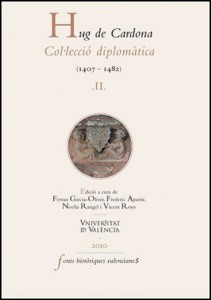 Hug de Cardona II
Hug de Cardona II
Col·lecció diplomàtica (1407-1482)
Ferran Garcia-Oliver, Frederic Aparisi, Noelia Rangel, Vicent Royo (eds.)
Valencia University Press (PUV)
Fonts Històriques Valencianes collection
Valencia, 2010
512 p.; 27×19 cm.
ISBN: 9788437078595
You can buy the book here.
–
–
–
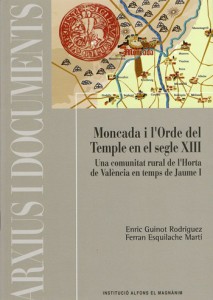 Moncada i l’Orde del Temple en el segle XIII
Moncada i l’Orde del Temple en el segle XIII
Una comunitat rural de l’Horta de València en temps de Jaume I
Enric Guinot, Ferran Esquilache
Alfons el Magnànim Institution
Arxius i Documents collection, 47
Valencia, 2010
234 p.; 24×17 cm
ISBN: 9788478225743
The Crown of Aragon expanded over the Sharq Al-Andalus in the thirteenth century in a general context of feudal expansion. This involved the colonization of new lands by lords and peasants and the city of Valencia and its hinterland were one of the major areas of Christian immigration from the North. In this sense, the study about the village of Montcada is a great chance to study the process of colonization in the urban periphery, thanks to the exceptional collection of scrolls kept in the archives of the Temple Order. The combination of archaeological and written documentation allows us to study in detail various matters, as the reconstruction of the Andalusian landscape at the time of the Christian conquest or the process of distribution of land made by the king in 1238 among the inhabitants of the Aragonese town of Calatayud. Later, in a second phase, these first settlers were replaced by Catalan ones when the Knights Templar had become lords of Montcada in 1246.
 Seifukuou Jaume issei Kunkouroku
Seifukuou Jaume issei Kunkouroku
Rekonkisuta senki wo yomu
Akio Ozaki, Vicent Baydal
Kyoto daigaku shuppankai
Kyoto (Japan), 2010
608 p.; 23×16 cm.
ISBN: 9784876989294
«Hajiwo sire, kisiachi, hajiwo sire»: in this way sounds in Japanese the famous «Vergonya, cavallers, vergonya!» from The book of the Deeds, as Japanese readers may pronounce it in this first version of the chronicle of James I in their own language, published by the Editorial Service of the University of Kyoto within the framework of University of Alacant IVITRA programme, with the support of the Valencian Academy of the Language, the Ramon Llull Institute, the Cervantes Institute and the Valencian Government DIGICOTRACAM project, and with the help of la Nucia Council and its University seat. Now, with this version there are four major languages (English, Castilian, French and Japanese) to which the chronicle of the King Conqueror has been translated, a new pass to encourage interest in the international study of feudal expansion in the Iberian Peninsula.
 Josep Camarena
Josep Camarena
L’arxiu d’un home i una època
Frederic Aparisi Romero, Carlos Lecuona Pérez
La Xara editions
Arxius i Famílies collection
Simat de la Valldigna, 2009
126 p.; 00×00 cm
ISBN: 9788495213822
Josep Camarena (1921-2004) was a cultural, educative and civic referent for the Saforshire (Valencian Country). After he obtained his doctor degree in medieval history with his thesis about Ferran d’Antequera and the kingdom of Valencia, his trajectory in the university was sliced by different reason, among them, the Manuel Dualde’s death, who had been his director of thesis and his mentor. However, he continued working now as a professor of Secondary and researching in his free time. In relation with this, it must be said that Camarena belonged to the first generation of Valencian historians who used the local history as a method for their researches. In the first part, written by Frederic Aparisi Romero, the work makes a study of the documents and books that Camarena left to Arxiu Històric de la Ciutat de Gandia. We have opportunity of relive his inquietudes and researches about the medieval Valencian history and many aspects of the local knowledge. In the second part of the work, Carlos Lecuona writes a Camarena’s biography connecting his life with the different historical moments of the 10th Century, from the Primo de Rivera dictatorship to democracy.
 Hug de Cardona
Hug de Cardona
Col·lecció diplomàtica (1407-1482)
Ferran Garcia-Oliver, Frederic Aparisi, Noelia Rangel, Vicent Royo (eds.)
Valencia University Press (PUV)
Fonts Històriques Valencianes collection
Valencia, 2009
512 p.; 27×19 cm.
ISBN: 9788437075310
The first volume of the edition of sources collects all Hug de Cardona’s documents until 1435 and, furthermore, a brief study in which the workers have tried to introduce the life of this Valencian noble. Alfons d’Aragó’s Grandson and Joan Ramon Folc de Cardona’s son, Hug de Cardona belonged to two of the most important lineages of the Crown of Aragon. However, his order in the noble hierarchy was secondary due to the modest of his lordship. In spite of that, far from the silence of other lesser Valencian nobles, Hug de Cardona adopted an active and dynamic attitude. He was introductory of the sugarcane farming in his lordship; he participated in the Courts and was an habitual of the Courts of Justice due to his non-payment, but these are only some of the aspects of his life, much more explain why a lot of sources have survived the time, enough sources to confect three volumes.
You can buy the book here.
 Xàtiva en temps de Jaume I
Xàtiva en temps de Jaume I
Expansió i colonització feudal
Frederic Aparisi, Noelia Rangel, Vicent Royo
Editorial Ulleye
Una ullada a la Història collection
Xàtiva, 2008
140 p.; 21×15 cm.
ISBN: 9788493549770
This book analyses the transformations and changes that the process of feudal conquest and colonization brings about a big Islamic city focusing on Xàtiva, in the Midlands of the Valencia Country, in the 13th Century. To explore this, its writers start their analysis with a part dedicated to the Islamic city considering different aspects, not only economic but also social and cultural. The second part is focused on military conquest and the resulting colonization of the landscape. Finally, the third section of the book studies the evolution of the feudal city during the reign of James I, paying attention not only to Christian society but also to the minorities, that is, Jews and Muslims. The book ends with a glossary that includes the most technical words.
You can buy the book here.
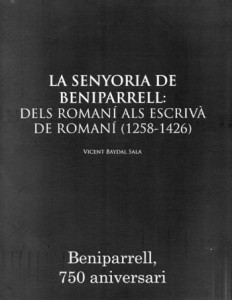 La senyoria de Beniparrell
La senyoria de Beniparrell
Dels Romaní als Escrivà de Romaní (1258-1426)
Vicent Baydal Sala
Council of Beniparrell
Valencia, 2008
265 p.; 28×24 cm.
ISBN: 9788469173862
La senyoria de Beniparrell (1258-1419): Dels Romaní als Escrivà de Romaní is an approach to the history of the manor of Beniparrell, a small town located some 10 kilometers south of the city of Valencia, from the donation made by the king James I to Arnau de Romany twenty years after the conquest of Balansiya until its transfer in 1419 to Manfré Escrivà de Romaní, the first member of the Escrivà de Romaní lineage, specifically created to inherit the manorial entailment instituted on this village in 1387. The book focuses on various issues concerning the medieval historical evolution of the kingdom of Valencia in general and of Beniparrell in particular through the documentation belonging to the different lords of the town (the monarchy, the Romanís, the Carthusian monastery of Portaceli, the Ripolls, the Escrivàs, the Ça-Moreras, and the Escrivà de Romanís).
You can read the book here (Valencian version).
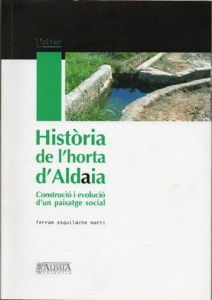 Història de l’horta d’Aldaia
Història de l’horta d’Aldaia
Construcció i evolució d’un paisatge social
Ferran Esquilache Martí
Council of Aldaia
L’Alter collection
Aldaia (Valencia), 2007
163 p.; 24×17 cm.
Halfway between the research and the popularization of science, Història de l’horta Aldaia is the first attempt to study in detail a large irrigated area through the techniques of the hydraulic archeology. The morphological analysis of the Quart-Benàger irrigation system is used here to prove the Andalusian tribal origins irrigated fields of Valencia and to know the formation of the plots of land of the Comuner d’Aldaia system farmed by the Christian settlers arrived after the 13th century feudal conquest. Finally it deals with the evolution of those plots and the management of the irrigated fields and its watering communities in the modern and contemporary times.
